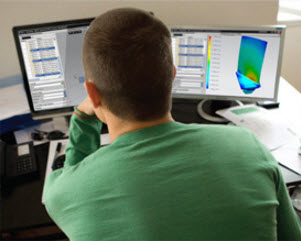Making the Change to Simulation-Driven Design


First, let’s start with the benefits. Why should you even care about simulation-driven design? Ever-increasing technology puts enormous competitive pressures on companies like yours. You have to stay ahead of, not just keep up with, your competitors. That means you must be on the cutting edge of the latest trends. You have to create the best products. At the same time, we live in a world with decreased attention spans and increased expectations, where even the phrase “In the blink of an eye” has become obsolete. Take the internet as an example. Say you have a question and wish to find the answer. Now you can simply go online, type your question in a search engine, and in three centiseconds you have a page full of results. That’s three times faster than you can blink!
What does this mean for product developers? Consumers and even businesses want things NOW. You need to deliver products faster than ever before, or risk falling behind and eventually becoming obsolete yourself. This pressure trickles down from the top level and falls on the employees who design, develop and test your products. Meanwhile, the increased expectations I mentioned earlier apply not just to the time it takes to deliver products, but also to the quality of your products as well. People don’t just want products faster; they expect them to retain the same level of quality or better than before.

Unfortunately though, when it comes to actually implementing simulation-driven design, it is not always easy. Now we’ll look at why that is and what steps you can take to overcome some of these barriers.
One of the biggest obstacles that stands in the way of achieving a change of philosophy in your organization to simulation-driven design is one of culture and mindset. Change is never easy, whether it be on an individual basis or an entire organization. Anyone who has ever tried to quit smoking or start eating right can tell you that much. It goes beyond engrained habits though. Many companies have processes in place that have worked for decades. Oftentimes when a change is suggested, a common response I hear is “If it isn’t broke, don’t fix it.” It is understandable to feel that way. However, think about how much design and simulation software has changed in the last few decades. Shouldn’t our processes change to reflect that?
Much of this resistance stems from a deep-rooted fear of the unknown. It’s human nature, but that doesn’t mean you can’t overcome it! This is why strong leadership is so important to the success of implementing a new way of doing things. You can reassure your employees and demonstrate the long-term benefits they will gain from the short-term “pain” of learning a new process. You have the ability to make this a success, and if you need help, there are always software experts from Siemens PLM Software who are willing to assist you.
There are also technological factors to consider that have historically held simulation-driven design back from going “mainstream” so to speak. While many, if not all, of these have been resolved by the aforementioned advancements in simulation software, they are still worth mentioning. It also gives us a good indicator of just how far we have truly come with respect to this.
The technological factors that come into play are ease-of-use, accuracy and speed. NX does a lot to address each of these concerns. Let’s start with ease of use. You can’t expect to introduce simulation earlier in the design process if designers aren’t able to actually use the software, and certainly not if the simulation analysts themselves struggle to get results. Ease-of-use matters when it comes to simulation-driven design.

Design engineers will appreciate a few features that help to increase usability in NX. For one, there is the fact that NX uses a completely integrated CAD and CAE platform. If a user is already accustomed to working in NX Design, then a switch to NX Simulation will barely be noticeable because it’s the same platform. The customizable user interface allows each user to tailor the simulation software to their experience level and needs. Furthermore, there are handy Simulation Wizards available in NX to assist users. The wizards guide the user step by step through the process of performing some basic checks on a model.
What does enabling designers to perform analysis have to do with simulation-driven design? It should come as no surprise that most simulation departments have far too few analysts to keep up with the backlog. When designers are able to check their models themselves, it reduces the simulation bottleneck, thus freeing the analysts to perform more complex simulations that drive innovation. That kind of simulation is the cornerstone of the simulation-driven design philosophy.
Improvements to accuracy deserve mention as well. The whole point of engineering analysis is to predict how products will perform once they’re out in the real world. If simulations aren’t accurate, the changes the design team makes based on those results won’t be either, and the product won’t perform as designed/expected. That leads to unhappy customers. Luckily, NX continues to expand the types of analysis one can perform. With the addition of new, very specific capabilities, NX continues to improve in accuracy.

There are many benefits that make the decision to go through a major change of process such as this worth it. Knowing the challenges you will face prepares you to deal with them as they arise, which goes a long way in helping to guarantee your—and your company’s—success in this transition. Ultimately, your support and help from your software solution provider can make all the difference as you move your employees toward a philosophy of simulation-driven design.


